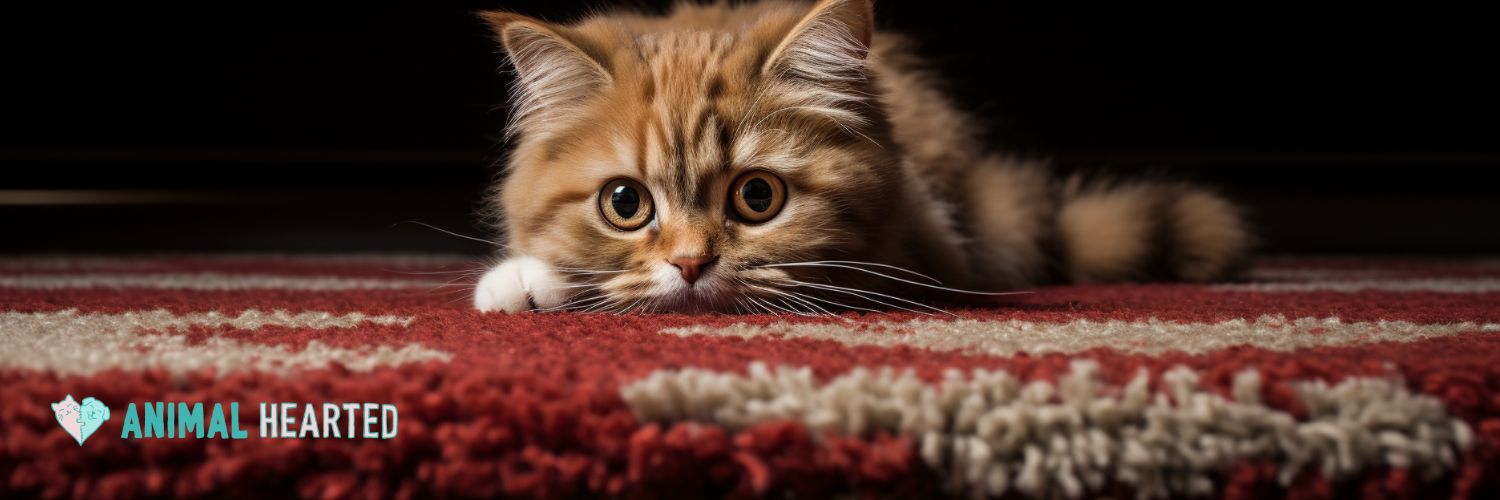shelter pets in need
Each order helps pets in need

Cats scratching furniture and carpets can be puzzling and sometimes frustrating for pet owners. Understanding this behavior is crucial because it's a natural and important activity for felines.
They scratch to maintain the health of their claws, mark their territory by leaving both a visible mark and a scent, and stretch their bodies. It's not just about destruction; scratching serves several purposes for your cat, including emotional expression and comfort.
While your sofa might not appreciate it, scratching enables cats to communicate and keep their hunting tools sharp. Providing suitable alternatives and understanding the drive behind the behavior can help you get your cat to use scratching posts or more appropriate outlets.
When your cat takes to scratching your favorite armchair or a section of your carpet, they're not just causing mischief. They're fulfilling natural instincts that are essential to their well-being.
Here are other reasons why cats scratch regularly:
Your cat's urge to scratch is ingrained in their DNA. It's a behavior that is both natural and necessary for their mental and physical health. Scratching helps them stretch their bodies and flex their feet and claws.
Scratching is your cat's way of leaving a visual mark and depositing scent from their scent glands on their paws. When they scratch, they're sending out a message and marking their territory, which is crucial for their sense of security.
Regular scratching helps your cat keep their claws sharp and healthy. It removes the outer nail sheaths to reveal new, sharper claws underneath, ensuring they're ready for self-defense, hunting, or play.

When your cat's got to scratch, they're often drawn to materials in your home that best mimic their preferred clawing textures in nature, like tree bark or grassy fields. Let's take a peek at where your feline friend might unleash those claws.
Furniture: You've likely seen your cat go to town on the arm of your comfy sofa or your wooden dining chair legs. They love the resistance these items offer, which helps remove the outer layer of their claws.
Areas like the corners of furniture are prime targets due not only to the texture but also because they provide a prominent place for leaving their scent and visual marks.
Wood: In the wild, trees are the go-to scratching posts, so wooden furniture in your home is the next best thing. Whether it's the legs of a table or an exposed wooden beam, the slightly giving nature of wood gives their claws that satisfactory hook and pull action.
Carpets: Your floors aren’t safe either. Many cats adore the feel of a good carpet's texture under their paws. Plus, the carpet often gives them a good grip and enough resistance to satisfyingly stretch their muscles.
Upholstery: Of all the things in your living room, your upholstered couch and armchairs might bear the brunt of your cat's scratching. The reason? The upholstery fabric often shreds in a way that seems to give your cat a sense of accomplishment.
Door Frames: Don’t overlook these! Door frames are a common victim of kitty claws, possibly because their vertical shape is just perfect for a good full-body stretch and scratch.
Stairs: If you have wooden or carpeted stairs, these areas can become prime real estate for your cat's scratching practice. The stair's edge provides a unique angle that's just too tempting for most felines to pass up.

When your cat takes to the furniture with their claws, they're not just causing mischief. They're often expressing complex emotional or behavioral needs through this natural activity.
Cats experience stress and anxiety, which can lead them to scratch as a way to cope with their feelings. It's a self-soothing behavior that releases pent-up tension and can make your kitty feel more secure in their environment.
For your feline friend, scratching can be about play and warding off boredom. They get a chance to stretch out their muscles and entertain themselves, making scratching a part of their daily playtime routine.
Sometimes, your cat may scratch your furniture because it's a surefire way to grab your attention. This attention-seeking behavior acts as a communication tool to tell you they want interaction or perhaps aren’t happy with the current level of attention they’re receiving from you.
When your cat starts treating your furniture like a personal scratching pad, it's time to take action. With the right strategies, you can start cat proofing your home and still keep your kitty happy.
Find the right scratching post for your furry friend; it should be tall enough for them to fully stretch. Cats need a dedicated scratching area that resembles the textures they're drawn to. Try posts made of carpet, sisal, or cardboard, and use catnip or toys to make them more appealing.
Training your cat starts with positive reinforcement. Praise and treats can work wonders when you encourage your cat to use their posts instead of your furniture. Consistency is key, so redirect them to the scratching post each time they go for the couch.
For areas that you can't monitor as easily, solutions like double-sided sticky tape can deter cats from scratching. Consider using nail caps as a gentle alternative to prevent damage. Remember, these are stopgaps; the real victory is redirecting to appropriate alternatives.
Leave a comment